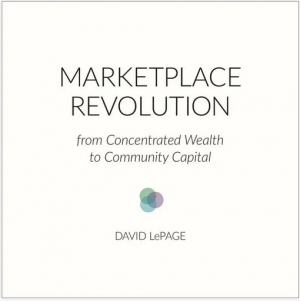 Review by Bernadette Johnson.
Review by Bernadette Johnson.
In his concise book, Marketplace revolution: From concentrated wealth to community capital, David LePage lays out his vision for a rethink on wealth and capital in communities. For decades, LePage has been one of Canada’s leading figures on the social enterprise scene. He sits as chair of the Social Enterprise Council of Canada, and is a member of the Government of Canada’s Social Innovation and Social Finance Steering Group.
In Marketplace Revolution, LePage leaves behind the myopia of social finance and innovation mechanisms, opting instead to advance the development of an ecosystem, what he calls an integrated “social value marketplace.” Rather than seeing innovation, technology, and investment as ends in themselves, he’d like society to focus on the social value generated by these forms of entrepreneurship.
 Rather than engaging in the nationalize vs. privatization binary, this is a plan to democratize local markets. The book offers the nonprofit sector an alternative conception of financing and of the sector’s relationship to government and local economies. It presents options for inner cities facing income disparities and rural communities experiencing economic upheavals and a population exodus.
Rather than engaging in the nationalize vs. privatization binary, this is a plan to democratize local markets. The book offers the nonprofit sector an alternative conception of financing and of the sector’s relationship to government and local economies. It presents options for inner cities facing income disparities and rural communities experiencing economic upheavals and a population exodus.
Lepage’s vision is founded on a new paradigm of “community capital,” a term that’s evolved over the course of his career and which refers to five kinds of capital that are necessary for healthy communities:
- Cultural: diversity and respect; arts and recreation
- Human: valuing learning, employment, health and training
- Physical: natural and built environment
- Economic: income equality and affordable living
- Social: people connections, the glue of communities
These are aspirational but achievable through the advancement of a social value marketplace, an ecosystem that’s made up of three things: (1) social enterprises by nonprofit and charitable organizations offering goods and services; (2) social procurement activity by governments and businesses; and (3) social value finance, which links supply and demand, and rewards value rather than financial gain.
As comprehensive as this is, I was initially drawn to this book for the emphasis on social procurement, a practice whereby governments and corporations use their spending power to purchase goods and services from social enterprises. (LePage is president and founder of Buy Social Canada, a social procurement accelerator.) This field is gaining traction as part of a potential means toward financial sustainability for nonprofit organizations. (For more on this, see recommendation #15 of Catalyst for Change: A Roadmap to a Stronger Charitable Sector, a Senate of Canada report.)
Published a few months into the COVID-19 pandemic, the analysis is relevant to a sector that has endured varied levels of despair through unprecedented funding constraints. The impact of COVID on the sector will lead to disparities among organizations in different subsectors. Nationally and locally, we are at an important juncture: the post COVID-19 era might present an opportunity to rethink capital, as nonprofits and charities lead local rebuilding efforts. LePage has been around long enough to see how governments can make choices during crises that further enshrine inequitable concentrations of wealth. Despite this, he’s hopeful.
Bernadette Johnson is Director of Mobilization & Engagement at Imagine Canada and a member of the Editorial Board of PANL Perspectives.
Wednesday, November 25, 2020 in Social Finance
Share: Twitter, Facebook



